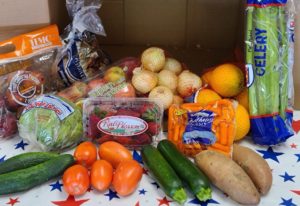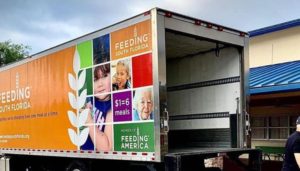Ever since it merged with a restaurant serving free community meals a year and a half ago, Feeding Tampa Bay envisioned that meal preparation would be a bigger part of its future. Suddenly, that future is here.
In response to the pandemic, the food bank is now coordinating the production and distribution of about 8,500 scratch-cooked meals a day. Its restaurant, known as Trinity Cafe, lies at the heart of an effort combining meal production at local commercial kitchens with meal delivery from Amazon, Uber Eats and the food bank’s own vehicles, enabling Feeding Tampa Bay to get frozen, re-heatable, single-serve meals to a variety of vulnerable populations, including seniors, school children and under-resourced communities.
Feeding Tampa Bay is among a growing number of food banks that are flexing their muscles in meal preparation, moving them a step beyond the traditional food-bank domain of distributing shelf-stable groceries and produce. The trend reflects a growing recognition that people struggling with hunger often face other obstacles, including a lack of time, to prepare healthy meals at home. It also acknowledges the needs of an aging population, which may lack the knowledge, skills — or just plain energy — to cook at home.

“We saw food relief moving in a direction that includes single-serve prepared meals,” said Matt Spence, Chief Program Officer at Feeding Tampa Bay. “Covid-19 gave us a reason to really dive in.”
Feeding Tampa Bay is not alone in its thinking about the future of food banking. In December, Greater Chicago Food Depository announced a $50 million effort to build a massive kitchen partly so it could prepare meals for a growing elderly population. Dare to Care Food Bank in Louisville, Ky., last October broke ground on a new kitchen that will be triple the size of its old one, allowing it to produce 2,000 meals a day for seniors, 50% more after-school meals, and supply its mobile retail market with frozen meals. Philabundance, Feeding South Florida and San Antonio Food Bank are among other food banks currently expanding their capacities in meal preparation.
In normal times, Feeding America’s Trinity Cafe produces 550 meals at its two locations, where patrons can sit at tables set with centerpieces, plates and silverware. Now it is preparing about 2,500 meals per day and making them available to-go.
In addition, it is making Trinity’s low-cost model of meal prep available to four other area commercial kitchens, including a restaurant, a hotel restaurant, a stadium caterer and a culinary company. These kitchens are producing an additional 6,000 or so single-serve frozen, re-heatable meals every day.
Rather than have its four commercial-kitchen partners produce meals at their typical costs, Trinity has shared with them its lower-cost labor and purchasing model. The model uses Trinity’s existing vendor relationships, which allow it to prepare fully nutritious menus at $2.50 a pop. “Trinity’s been around for 19 years, and we’ve been honing that low-price model over that length of time,” Spence said, adding, “It’s been an incredible blessing that we merged with Trinity.”
The prepared meals are getting out into the community in a number of ways, including through food trucks that Feeding Tampa Bay sends into under-resourced neighborhoods, child meal sites, and home deliveries to seniors. Uber and Amazon Flex drivers handle the deliveries to local senior-citizen facilities, dropping off five to seven frozen prepared meals at a time per resident.
At Houston Food Bank, frozen, re-heatable, single-serve prepared meals have emerged as essential to the food bank’s ability to efficiently feed school children who can no longer access meals at school. The food bank is delivering prepared meals to nearly 800 households that include more than 2,000 kids, mostly by dropping them off in bulk at several large apartment complexes around the city. It has the capacity to ramp up to about 1,400 households in total, said Stephanie Berno, Director of Outreach Services.

Houston Food Bank was early to the meal-prep trend, opening up a 10,000-square-foot kitchen in its headquarters building in 2016, according to Berno, improving upon a much smaller kitchen previously run in a separate location. The kitchen fulfills Houston Food Bank’s ambitions to address child hunger, one of its main strategic goals.
Before the pandemic, Houston Food Bank did not freeze student meals. Now that it is doing so, it can deliver five to seven meals at once, along with an equal number of shelf-stable breakfasts, allowing it to take advantage of government waivers that let children receive more than one meal at a time. “I can’t deliver meals to your home every day,” Berno noted, “but I can do it once a week.”
Getting into frozen prepared meals has not been without its challenges. Houston Food Bank is straining for freezer space, and is currently utilizing four freezer trailers as it seeks additional freezer and warehouse space. Fulfilling the specific USDA requirements for milk has also been an issue, especially given the short supply of shelf-stable milk. As a remedy, the food bank has been experimenting with freezing fresh milk, Berno said.
On the positive side, Houston Food Bank has gained access to data it wouldn’t normally get about community needs, as families fill out applications for home delivery. Plus it is planning to survey meal recipients during the first week of June, allowing it to better tailor meals. When the pandemic is over, Houston Food Bank will continue its focus on kids’ meals, but with greater knowledge of specific needs in the community, Berno said.
Feeding Tampa Bay, too, expects it will be doing more of the same, but better, once the pandemic is over. It had already been building toward a future that included a more nimble response to hunger through single-serve prepared meals. “I’m sure this will stay with us beyond the crisis,” Spence said.














